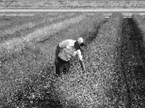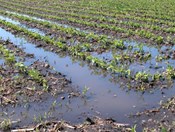Area Regional Crop Specialist Kevin Ganoe addresses the current situation from too wet to flood conditions in many fields in the latest isssue of the "Checking the Back Forty".
Wet Fields: The problems with wet fields go from being unable to harvest hay crops to unplanted fields. A couple thoughts for being unable to harvest. If you are lacking quality feed don’t worry about those fields that are first cutting that hasn’t been harvested. That hay will never get better in quality. Keep after the fields that you can do multiple cuttings through the end of the season. These are likely the driest fields and given the rainfall we have had should reward with good quality growth. As a matter of fact if you get cuttings off these fields and they have a signifi-cant amount of grass applying nitrogen will pay as there is plenty of soil moisture to drive the next cutting.
Corn fields that are light green to yellow are likely nitrogen deficient and you should consider a sidedress N application, provided you can get in the field. To be clear this is not addressing traditionally wet areas where not only denitrification has taken place but plants are actually stunted by the excessive water. There are fields, and likely you have a few, that given normal rainfall or less you usually have enough nitrogen applied. This year whole fields have been sat-urated, not just the wet spots, long enough that denitrification has taken place. This is more likely to take place on finer textured soils. Possibly higher organic matter fields or fields with high manure application rates may still mineralize N to the end of the season. It may not turn out to be practical to make a sidedress application given how wet the fields are and/or how tall the corn is but I offer you consider it.
If you have corn fields that are yet to be planted you can still plant corn but as we hit July 10-20 we are definitely on the road to drastically lower yields. After July 20 don’t bother. It has been shown as you go later in the season and only getting what ever fodder you can that later corn and at higher populations can give higher yields. All I would offer is that if you have corn seed and a planter ready to go just go get the seed in the ground. Another thought is to now hold off until the end of July and plant a spring grain like oats. Oats planted by Aug 1 can make some great forage both in quality and quantity by the end of September.
Flooded crops: First if you have any flooded crops make sure you report them to the local FSA office and your crop insurance agent before taking steps to do anything with them. Document the damage done. If you have had crops flooded by one of the local rivers or creeks do not feed these crops.
Corn that hasn’t been damaged by the flow of water and silt and under water less than 24 hours is likely to recover. Corn that was flooded at this stage could be harvested above the silted area come fall.
Soybeans at their current stage again are just approaching flowering and as long as they haven’t been damaged by the flow of water and silt and under water less than 24 hours are likely to re-cover. Damage to a harvestable crop should be minimal because pods have yet to form.
All standing hay and pasture should be removed from the field if possible especially if you are trying to get any growth out of the remainder of the season. It should not be fed or used for bedding. This may be most easily accomplished by harvesting as large round bales. Blowing back on the field using a chopper is a possibility, one to be used reluctantly, if cut short and you feel fairly confident of a lack of debris. Running any of this silt covered material through machinery is likely to cause excessive wear. It would be a good idea to wash/sanitize machin-ery when done. Also there will a great deal of dust when working with this material so the use of appropriate dust masks is encouraged. Keep animals out of flooded pasture areas until at minimum they can be clipped and you have checked for debris. Best if animals are kept out until next spring. Pastures that have had exces-sive silting and may have had plant loss may be need to be reseeded. Legume and grass plants will probably recover from modest amounts of deposited silt, 1-3 inches. Beyond that may mean the need to replant because the plants have been smothered.





